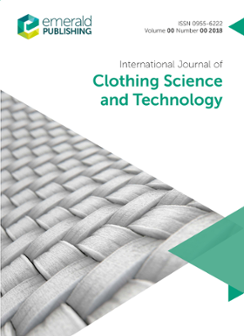Table of contents
The effect of selected mechanical properties acquired by the KES‐F instruments on the level of puckering of cotton fabrics after washing
Lubos Hes, Fatima M. Pinheiro, Miranda M.C. Goncalves, Arthur Cavaco‐PauloDescribes a research project in which a cotton twill fabric was subjected to various finishing treatments. Then the level of puckering of finished fabrics before and after washing…
Influence of washing/ironing cycles on selected properties of cotton type weaves
Jiˇrí Militky, Vladimír BajzíkDescribes an experiment designed to investigate the influence of washing/ironing cycles and softening after sanforization on the hand grade, shrinkage and surface roughness of…
Problems in recently manufactured worsted men’s suiting from the point of view of suit quality
Kitoshi ItoExplains that men’s suit manufacturing has been industrialized and the line production system is now popular in suit manufacturing. As a trend in the suit manufacturing industry…
An experiment on human sensory measurement and its objective measurement: Case of the measurement of seam pucker level
Sueo Kawabata, Miyuki Mori, Masako NiwaPresents a report on a recent experiment on the evaluation of seam pucker level by the objective method. Explains that human beings measure physical quantity and quality by means…
Objective hand evaluation of non‐wovens used for nappies
Hiroko Yokura, Masako NiwaDescribes an investigation into the hand of non‐wovens used for nappies under both dry and wet conditions. The mean score of the subjective hand assessments (THVsub) of dry nappy…
Analysis of “wet” sensation for lingerie fabrics
Sachiko Sukigara, Masako NiwaDescribes an investigation into the sensation of wetness and dampness by both subjective and objective measurements. When fabric has a high water content, the subject felt a…
Effect of seams on fabric drape
Jinlian Hu, Siuping Chung, Ming‐tak LoPresents a study of the relationships between fabric drapeability and seam allowance, seam position and seam directions in terms of drape coefficient, bending length and draped…
The causes and prevention of rippling or localized delamination in fused garment parts
J. Fan, W. LeeuwnerExamines the causes of rippling, localized delamination or surface distortion in fused garment theoretically and experimentally. On the basis of this study proposes a parameter…
Evaluation of rheological properties of a thread using numerical methods
Jelka GerˇsakConsiders the complexity of a problem of thread’s rheological properties evaluation, and evaluates the visco‐elastic properties of a thread on the basis of static tests using…
Sewing needle penetration force study
Karl GotlihDemonstrates the modelling of the kinetic process when the sewing needle enters the fabric. To get an adequate mechanical model of the given problem, the function ‐ the…
Integrated 3D sewing technology and the importance of the physical and mechanical properties of fabrics
Philipp MollPresents a new sewing technology developed by Moll Automatische Nähsysteme GmbH, a German company. This allows complex shapes to be sewn in three dimensions as well as providing…
A new evaluation of seam pucker and its applications
Chang Kyu Park, Dae Hoon Lee, Tae Jin KangThe AATCC grades of seam pucker do not provide sufficient information for analysing and solving the problems. Develops a new measurement system which redefines seam pucker with…
Dynamic clothing simulation based on skeletal motion of the human body
Takatoshi Saeki, Takao Furukawa, Yoshio ShimizuDescribes the construction of an interactive apparel design system using the Word Wide Web. The system permits end‐users to design clothes reflecting their tastes. Variable…

ISSN:
0955-6222Online date, start – end:
1989Copyright Holder:
Emerald Publishing LimitedOpen Access:
hybridEditor:
- Prof George Stylios